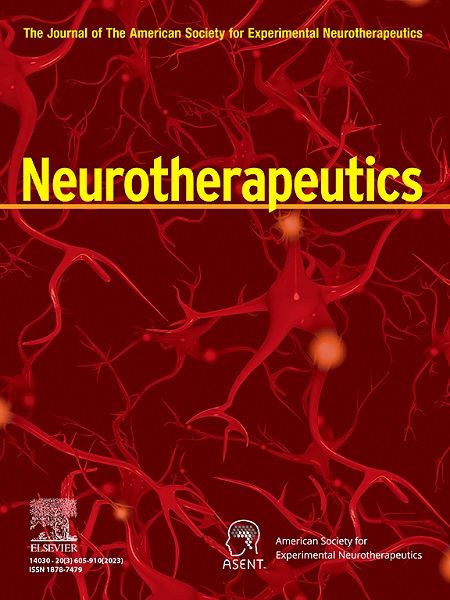ProSavin®基因治疗帕金森病后,脑深部刺激耐受性良好且有效。
IF 6.9
2区 医学
Q1 CLINICAL NEUROLOGY
引用次数: 0
摘要
帕金森病(PD)是一种神经退行性疾病,最初用口服多巴胺能药物治疗。当运动波动和副作用在这些治疗中出现时,使用丘脑下核(STN)的深部脑刺激(DBS)。纹状体多巴胺替代,使用慢病毒载体基因疗法(GT),先前显示耐受性良好,导致运动功能的临床改善。后来,其中一些患者表现出疾病进展的迹象,由于新的GT注射尚未获得监管机构的批准,因此建议进行DBS。报道了该队列DBS的耐受性和运动疗效。8名先前接受过GT的患者(GT/DBS组),在DBS前和12个月后进行评估。以84例接受DBS治疗的PD患者作为对照组(DBS组)。GT/DBS组患者在PD诊断后给予DBS的时间明显晚于DBS组(19.6年vs 12.1年)。两组的严重不良事件发生率相似,DBS后12个月的UPDRS III MEDSOFF评分和基线DBS和DBS后12个月的LEDD减少。与基线DBS相比,GT/DBS组在DBS后12个月UPDRS III MEDSOFF/STIMON轴向评分的下降明显大于DBS组。在GT/DBS PD患者中,STN的DBS与DBS组一样有效且耐受性良好,即使在病程后期给予也是如此。本文章由计算机程序翻译,如有差异,请以英文原文为准。
Deep brain stimulation is well tolerated and effective following ProSavin® gene therapy for Parkinson's disease
Parkinson's disease (PD) is a neurodegenerative disorder initially treated with oral dopaminergic medications. When motor fluctuations and side effects develop on these treatments, Deep Brain stimulation (DBS) of the subthalamic nucleus (STN) is used. Striatal dopamine replacement, using a lentiviral vector-based gene therapy (GT), was previously shown to be well-tolerated, leading to clinical improvement in motor function. Later, some of these patients showed evidence of disease progression and were proposed DBS since new GT injection was not yet authorized by regulatory authorities. The tolerance and motor efficacy of DBS in this cohort is reported. Eight patients who had previously received GT (GT/DBS group), were evaluated pre- and 12 months-post DBS. A control group of 84 PD patients who had received DBS, were used for comparison (DBS group). Patients in the GT/DBS group were administered DBS significantly later after PD diagnosis than the DBS group (19.6 vs 12.1 years). Similar rate of serious adverse events, UPDRS III MEDSOFF scores 12 months post-DBS and reduction in LEDD between baseline DBS and 12 months post DBS were reported in both groups. The decrease in axial scores from UPDRS III MEDSOFF/STIMON at 12 months post-DBS compared with baseline DBS was significantly greater in the GT/DBS group than in the DBS group. DBS of the STN was as effective and well-tolerated in GT/DBS PD patients as in the DBS group, even when administered later in their disease course.
求助全文
通过发布文献求助,成功后即可免费获取论文全文。
去求助
来源期刊

Neurotherapeutics
医学-神经科学
CiteScore
11.00
自引率
3.50%
发文量
154
审稿时长
6-12 weeks
期刊介绍:
Neurotherapeutics® is the journal of the American Society for Experimental Neurotherapeutics (ASENT). Each issue provides critical reviews of an important topic relating to the treatment of neurological disorders written by international authorities.
The Journal also publishes original research articles in translational neuroscience including descriptions of cutting edge therapies that cross disciplinary lines and represent important contributions to neurotherapeutics for medical practitioners and other researchers in the field.
Neurotherapeutics ® delivers a multidisciplinary perspective on the frontiers of translational neuroscience, provides perspectives on current research and practice, and covers social and ethical as well as scientific issues.
 求助内容:
求助内容: 应助结果提醒方式:
应助结果提醒方式:


